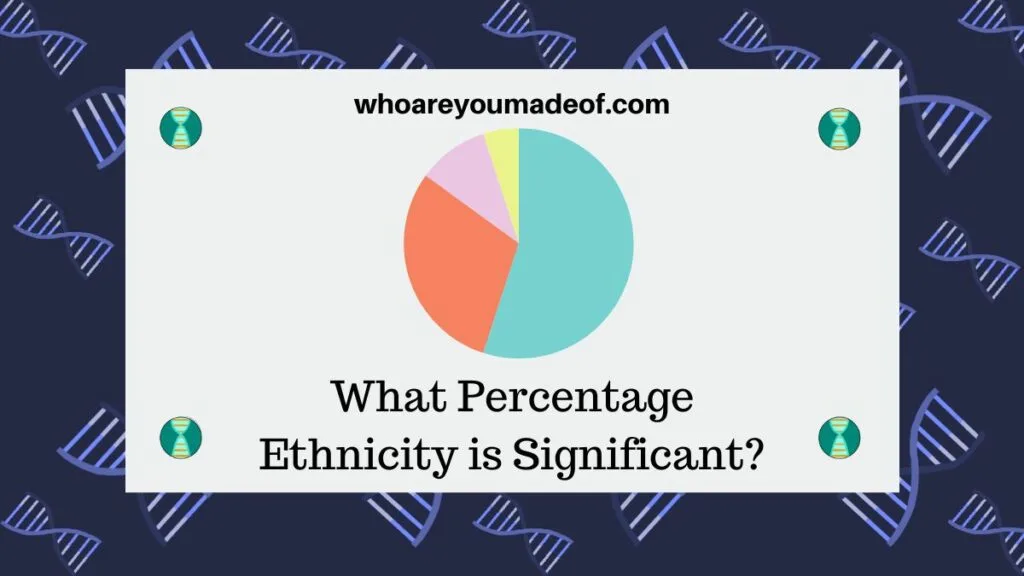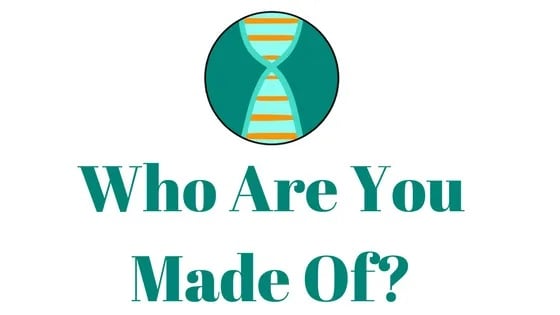Do you want to know what percentage ethnicity on your DNA results is considered significant? In this post, we'll discuss the answer to this question - and more.

Some people are surprised by the regions that they see on their results, and others are not surprised at all. Many people take a DNA test to learn about their distant ancestry that they might not have direct knowledge about, while others take a test to confirm what they know about their family tree.
How you might feel about the regions that you see on your results depends on what you knew about your ancestors before you took your test, and what you were hoping to discover.
One common question, especially when it comes to the regions that show up with smaller percentages on our results, is how much DNA matching a particular region is significant.
What percentage DNA is considered significant?
There is no specific or correct answer to this question. The percentage of DNA that is significant is relative, and will be different from person to person.
Exactly what does this mean?
I might find that 1% of an unexpected region is significant to me because I didn't know that I had ancestors who may have lived in that area. This might be very interesting to me, and I might want to spend time researching and trying to identify who passed DNA matching this region down to me.
Someone else might see the same 1% on their results and shrug their shoulders, since they might know that 1% DNA matching a part of world was likely inherited from an ancestor from as far back as seven generations ago - or more.
Small percentages could validate family stories
Some people choose to take autosomal DNA tests to test their ancestry because they have heard a story about an ancestor and would like to confirm whether it is true. While DNA results often lead to more questions than answers, they do occasionally provide the evidence that a person is looking for.
A small percentage on an ethnicity estimate would be significant if it matched with a family story. It could be interpreted as evidence that the story might be true.
Further research should always be conducted, of course.
For example, my mother's family always said that my grandmother's family was Jewish. My grandmother never spoke of being Jewish, or of having Jewish ancestors, so there was never any evidence.
It was only a story.
However, when my family starting taking DNA tests, we found that my mom, as well as her siblings, and first cousins, all showed that between 3-7% of their DNA matched the Ashkenazi Jewish (European Jewish) region on Ancestry.
This meant that one of my great-grandparents may have had as much as 14% or more Jewish DNA, had they been able to take a DNA test. We likely had a 4th great-grandparent in our family tree who was "100%" Jewish, and this may have led to the family stories about my grandmother being Jewish.
Small percentages can lead to a mystery
Many people take DNA tests hoping to discover something new about their ancestors. If they find a small percentage, even only 1-2% matching an unexpected region, it can lead to an exciting journey through the family tree in an attempt to solve the mystery of of where this DNA came from.
In the case of a small percentage leading to a mystery, and hopefully the solving of the mystery, these small numbers can be considered significant.
Take, for example, my daughter's 3% Basque and 5% Senegal, or my husband's 94% Indigenous Americas combined with several smaller regions, like 1% Cyprus. These are great mysteries to attempt to solve.
Larger percentages can provide a sense of belonging
A large percentage on an ethnicity estimate might be significant to the test taker because it could help them feel a sense of belonging to the ethnic group indicated on their results. How meaningful these percentages are will depend on the individual and what they were hoping to learn from their DNA test.
My grandmother's German and Polish parents died of tuberculosis while she was a child, and she spent several of her years during her childhood in an orphanage. Even though my grandmother knew that her ancestors were from those countries, she passed down little cultural knowledge to my mother.
My mother also had a Slovak grandfather on her father's side of the family.
So, I felt an affinity for these Central and Eastern European countries and cultures, and knew that I might "look" like I had ancestry from there, but I had little first-hand knowledge of the language or culture of these places. I felt like there was something missing from my understanding of my family's cultural heritage.
Through taking a DNA test, I learned that more than 48% of my DNA matches the Eastern Europe and Russia, Germanic Europe, and Jewish regions. This felt significant to me at the time because I felt like it was confirmation that it would be okay for me to search for what I felt was missing.
Since taking my test, I have taken it upon myself to "rediscover" my ancestors' cultures through learning about their languages, histories, customs, and teaching myself how to cook foods from these cultures.
More importantly, I am passing this knowledge down to my children so they have a better understanding of their family story.
Large percentages can be life-changing, too
Sometimes, large percentages on an ethnicity estimate can be paradigm-shifting. This most often occurs when a person takes a test and discovers that the person that they thought was their biological parent was not, which anyone would agree is significant.
While DNA ethnicity results can and should not be used to prove paternity, they can sometimes provide a clue about our biological ancestry. I have seen many scenarios where a person saw around 50% of a completely unexpected ethnicity on their results, leading to the discovery that one of their parents was not their biological parent.
One of my parent's cousins, who we did not know about until we all took DNA tests, had this exact scenario. My cousin did not know who their biological father was while growing up, but had assumed based on family stories that it was a man from the Caucasus region of West Asia.
My cousin was surprised to learn that their father's ancestors were from Central and Eastern Europe, and this affected their sense of identity for a period of time because they had always believed that they had ancestry from the Caucasus.
Conclusion
I hope that you have found this discussion interesting that you have discovered a few different ways to think about what might be considered "significant" on a DNA ethnicity test.
I am interested to know what you think is significant on your own results, and why!
If you have any questions about something that you read here, please join in the discussion below.
Thanks for reading today.

Arlene Slobecheski
Monday 6th of January 2025
This all sounds so much like my own story. I was always told that we were English and Irish with some German thrown in. My mother was always teased by her same-age nephew that she was Polish and she always dismissed it. When taking my DNA test it came back English, Germanic, and Eastern European. I was so thrilled to find this out as I have always been interested in Northwestern Europe. Now my ethnicity has come down to 27% Central & Eastern Europe, 26% England & Northwestern Europe, 20% Germanic Europe along with all of Scandinavia and the Baltics. How surprised and thrilled I am. Of course along with this still goes my Irish roots and even tiny percentage of Native American. I have discovered my unknown Polish Russian great-grandparents and given them the recognition that they deserved and have thanked them for traveling their path to me.
Stephen Squires
Sunday 5th of January 2025
I have an unexpected region in my dna: <1% Southern China. I have a theory that this is due to a Great, great uncle on my mother's side, as he was a sailor and may have travelled to the far east but I have no idea how to test my theory.
Suzanne G McClendon
Sunday 5th of January 2025
For the most part, the majority of my ethnicity results were not a surprise: Irish, Scottish, English, etc. I was surprised to find 5.7% North African and a very small percentage of Yemenite Jew. The surprise backed off a good bit when I had my mtDNA tested and it pointed to Morocco, which is in North Africa. The 5.7% North African, if it all came from one ancestor, should be around 2nd or 3rd great-grandparent. My matrilineal line has a brick wall at my 2nd great-grandmother. So, in this case, that 5.7% could be very significant.
The biggest surprise, though, was life-changing. I learned that my daddy was not my biological father. He never knew it and had passed away 6 years before I got my test results. After a major meltdown/breakdown, and with the help of DNA helpers, my biological father was found. He never knew that I existed, and I guess is still processing this revelation all these years later. We don't have a relationship. 70+ years old is a bit late to have an unknown daughter dropped at your doorstep, I guess.
I know who I am now, but not what caused this to be the case (aside from the obvious!). There were stories of bad things happening to my mother and that I was likely the product of one of those experiences. One was disproven. There's no way to prove or disprove the others.
Thank you for an interesting article. Have a blessed day.
Caroline Hayes
Friday 5th of April 2024
My father was born in Scotland of parents from the highlands. His father said that they originally came from Cavan in ireland. My mother and her half sister were born in Hannover, Germany. My DNA shows 25% Scots/Irish. 25% Eastern European/Balkan and the biggest puzzle ever - 50% English! does that mean both my parents have English ancestry.
Sheila Seiferlein
Monday 18th of March 2024
Thank you! My biological sister told me there was Native American in the family. I tested and yes there is, so the old family story is correct. Strangely, she did not inherit it but I did. And I've learned so much about my archaic mixture--it's all fascinating.